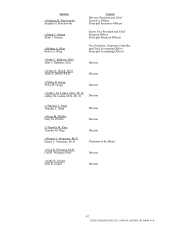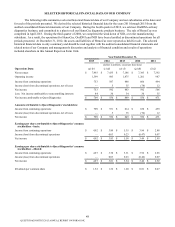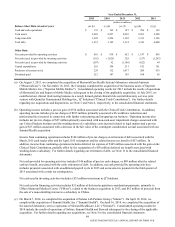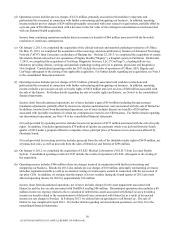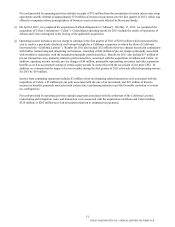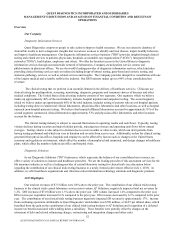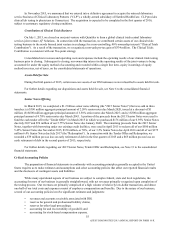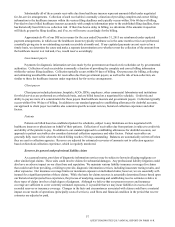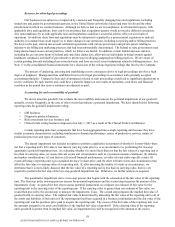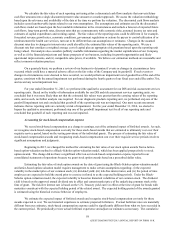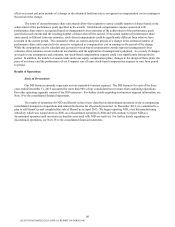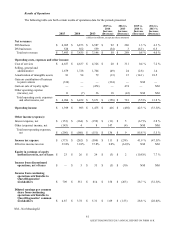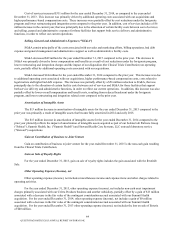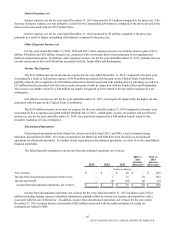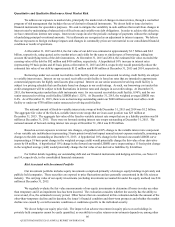Quest Diagnostics 2015 Annual Report Download - page 60
Download and view the complete annual report
Please find page 60 of the 2015 Quest Diagnostics annual report below. You can navigate through the pages in the report by either clicking on the pages listed below, or by using the keyword search tool below to find specific information within the annual report.
56
Revenues and accounts receivable associated with DIS
The process for estimating the ultimate collection of receivables associated with our DIS business involves significant
assumptions and judgments. We primarily recognize revenue for services rendered upon completion of the testing process.
Billings for services reimbursed by third-party payers, including Medicare and Medicaid, are generally recorded as revenues
net of allowances for differences between amounts billed and the estimated receipts from such payers. Adjustments to the
allowances, based on actual receipts from the third-party payers, are recorded upon settlement as an adjustment to net revenues.
We have a standardized approach to estimate and review the collectibility of our receivables based on a number of
factors, including the period they have been outstanding, which results in increased allowances for doubtful accounts
requirements as the aging of the related receivables increases. Historical collection and payer reimbursement experience is an
integral part of the estimation process related to revenues and allowances for doubtful accounts. Changes to the allowances for
doubtful accounts estimates are recorded as an adjustment to bad debt expense within selling, general and administrative
expenses. Less than 5% of our net accounts receivable as of December 31, 2015 were outstanding more than 150 days.
We believe that the majority of our bad debt expense is primarily the result of the failure of patients to pay the portion
of the receivable that is their responsibility; the remainder is primarily the result of missing or incorrect billing information on
requisitions. In addition, we regularly assess the state of our billing operations in order to identify issues which may impact the
collectibility of receivables or allowance estimates. We believe that the collectibility of our receivables is directly linked to the
quality of our billing processes, most notably those related to obtaining the correct information in order to bill effectively for
the services we provide. As such, we continue to implement “best practices” and increase the use of electronic ordering to
reduce the number of requisitions that we receive from healthcare providers with missing or incorrect billing information. We
believe that our collection and allowance estimation processes, along with our close monitoring of our billing operations, help
to reduce the risk associated with material adjustments to reserve estimates.
The following table shows current estimates of the percentage of our total volume of requisitions and net revenues
associated with our DIS business during 2015 applicable to each payer group:
% of % of
DIS DIS
Volume Revenues
Healthcare Insurers (including coinsurance and deductible responsibilities) 44 - 48 48 - 52
Government Payers 14 - 18 17 - 21
Client Payers 34 - 38 26 - 30
Patients 1 - 3 1 - 3
The following table shows net accounts receivable associated with our DIS business as of December 31, 2015
applicable to each payer group:
% of
Consolidated
Net Accounts
Receivable
Healthcare Insurers 16
Government Payers 16
Client Payers 44
Patients (including coinsurance and deductible responsibilities) 17
Total DIS 93
Healthcare insurers
Reimbursements from healthcare insurers are based on negotiated fee-for-service schedules and on capitated payment
rates.
QUEST DIAGNOSTICS 2015 ANNUAL REPORT ON FORM 10-K



